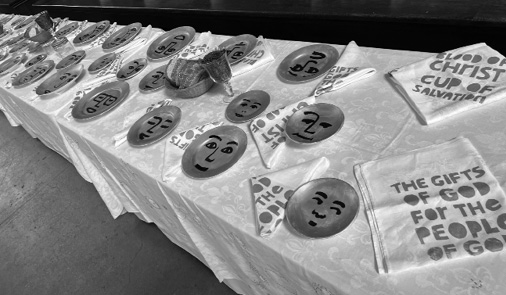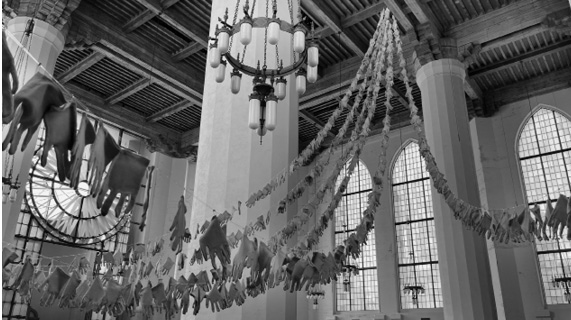A pilgrimage to Sacred Spaces, experienced through art
Last summer, I was invited to participate in a “Sacred Spaces” experience on the theme of Pilgrimage at Saint Mark’s Cathedral in Seattle—specifically to envision and create a large art installation. The two themes of communion and baptism were suggested to me as a place to start.

'Communion of Saints,' found tablecloths, screenprinted napkins, painted plates, basket, sponges, chalice. 18' w x 3' d
In the spring, I had led an art activity where people created a small screenprinted piece of art to take home. I provided the stencils which depicted a sun (for the light of God) and a pair of hands that symbolize the laying on of hands during prayers for the people who were being confirmed and baptized that day. This project provided the third theme.
As I spent time sketching ideas for the three themes, I realized that all three had potential to fill the vast expanse of the Nave of Saint Mark’s Cathedral. As each one came to life in my mind, I gave them names: “Communion of Saints,” “Waters of Baptism,” and “Hands of Pilgrimage.” As the ideas came to me as three-dimensional sculptural pieces, I envisioned that each one would be made of different materials and each one would have a different way of viewing: one would appear like a real-life still life on a table which you view looking down, another would be a wall-sized mural, viewed straight ahead, and the third would be a grouping of massed objects which hang from the ceiling so to be viewed by looking up.
I put together my concept sketches, with photo mock-ups and a description of each idea to present to the team responsible for the Pilgrimage experience, for approval. I was excited to produce three large pieces rather than just one and I knew that I could engage help from the Saint Mark’s community in creating each one through art workshops where people of all ages could participate.
One evening, before I had even started on the project, I attended a session on the theologian Evelyn Underhill, presented by Dr. Robyn Wrigley-Carr (theologian at University of Divinity, Sydney, Australia) hosted by Saint Mark’s Cathedral. While I had heard of Underhill previously and had done a little reading about her, I found myself taking copious notes to document as much of the compelling ideas that Robyn presented as I could — she simply brought to life Underhill’s writings and point-of-view in every sentence she spoke. This session brought new meaning and depth to the ideas I had for my art installations and breathed new life into each one. It was the perfect timing and it felt like the Holy Spirit was at work!
Now the work began. I ordered supplies, I planned the sequence of creation and construction, and I scheduled art workshops.
For “Communion of Saints,” we created a long table, comprised of three six-foot tables covered with white tablecloths: a feast, with room for all. On the table we placed dozens of plates in a variety of sizes, painted gold with added faces created with simple brushstrokes. The gold reminds us that we are created in the image of God. We screenprinted cloth napkins with the words of the Eucharist: Body of Christ, Bread of Heaven, Blood of Christ, Cup of Salvation, and The gifts of God for the people of God. The napkins were folded, making the type appear somewhat abstract, in a pleasing way. The bread was made from hardware store sponges, cut and painted to look like bread. I created the cup of wine using maroon cording, coiled into three found chalices. I visualize all the saints in my life hovering above this table, a visual way of encountering the Eucharist. Evelyn Underhill wrote of the idea that communion is an art form of movements: of bread and wine and words —enough to close the gap between the senses and the invisible—the food of eternity. These ideas infused my art-making as I was working on this piece. I had a lot of help from my daughter, Elsie, husband Chris, and other people at art workshops and I shared these ideas with the participants—it brought the project to life for them, too. A feast, where there’s room for everyone at God’s table and all are welcome—and there’s food enough for all people.

'Waters of Baptism,' plywood panels, birch panels, paint. 24' w x 4' h
The “Waters of Baptism” piece is a wall-sized mural (4-feet high by 24-feet wide) made up of 150 - 8" x 8" square painted wood panels that are attached, by hanging on nails, to three pieces of plywood which hang side-by-side. There’s a continuous image of water flowing, some light and wavy and some dark and turbulent, painted in blues on separate panels by many different people. It looks a little like a mosaic since there’s space between each panel but there’s a unity to the whole image when viewed from a distance. Each panel is needed to create the full image — just like each person on earth is needed in God’s creation. There’s a stripe of gold paint that meanders throughout the image to symbolize the presence of the Holy Spirit in our lives. I realized that rather than the gold stripe following the same lines as the water, it needed to be a wildly meandering line — more animated and more grand in gesture. I needed the representation of the Holy Spirit to show that God’s love can flow through us to others and that God’s light can penetrate the darkness, in a deep way. There’s a brilliant presence of the unchanging God, every day, when we are attentive and open to God’s quiet voice. When there are difficulties in life, if we are infused by the Holy Spirit, we can accept the difficulties with a spirit of peace.

'Hands of Pilgrimage,' dyed cotton gloves, gold safety pins, loop line.
For the “Hands of Pilgrimage” installation, we used more than 700 white gloves, the kind that are used to handle archival materials. We dyed them a sage green color, to create an immersive, suspended-from-above massive symbol of hands. Again, I had help from various people to create this piece. Each glove had to be placed on a hand to give it the proper human form and to stretch it out — this infused some humanity into each glove. On index cards, we wrote the word “eternity” in pencil, as a “whisper” to remind us to attend to God each day. This was inspired by the stitched word “ETERNITY” that Underhill had on the mantle at her retreats: a word of focus, a reminder to give ourselves to God, to feel and find the eternal each day, to rest and stay centered. These index cards were folded and placed into each glove. The gloves were then pinned with gold safety pins to long lines of fishing loop wire—the gold of the safety pins symbolizing the Holy Spirit, again. Six long lines of gloves were attached to the wall on one end, spaced several feet apart, and the other ends were attached to a metal loop with a rope that descended from the ceiling, 100 feet above, so the whole thing could be elevated above people’s heads. My husband, Chris, ascended the ladder into the attic to raise the lines of gloves...it was dramatic to see them rise! These are hands of pilgrimage, suspended from above, to be a blessing and company on the journey. We are not alone. The gloves symbolize that we are living vessels of God’s love. They create a collective embrace, a comforting reminder of companionship on life’s pilgrimage. The whisper of “eternity” on those handwritten index cards is a powerful blessing. I invited visitors to write their own prayer or intention on an index card, insert it into a glove and hang the glove onto a lower line—we gathered nearly 100 more hands for this added piece.
My hope is that each art installation offered contemplation and space for each person to experience it their own way—there’s room for individual interpretation and spiritual connection.
Visitors to the cathedral last summer were invited to participate in other activities as well. On Sundays and Wednesdays, there were short prayer liturgies at noon followed by contemplative recitals of music. A docent led tours of the cathedral, too, explaining the history of the building and its ministries over the years. There was a labyrinth in one corner and a station to create way-finding cairns from flat stones. This eight-week program was funded by a grant from the Calvin Institue of Christian Worship—and Saint Mark’s was host to hundreds of people who might have never visited before.
On the last day, we hosted a festive closing reception with treats and music. Chris, Elsie and I provided the recital music; we played and sang 12 pieces, with guitar, banjo, accordion and piano. It was a delightful way to close out such a special summer experience.
To view three short artist statement videos, showing the creating of each piece, visit: saintmarks.org/2024/06/sacred-spaces/
